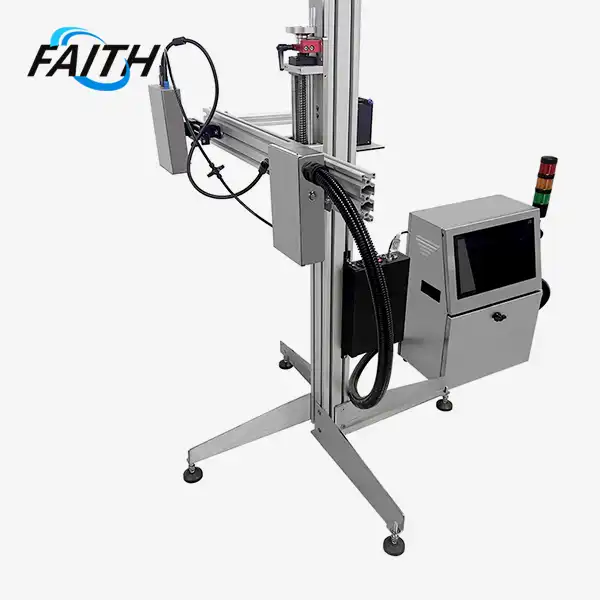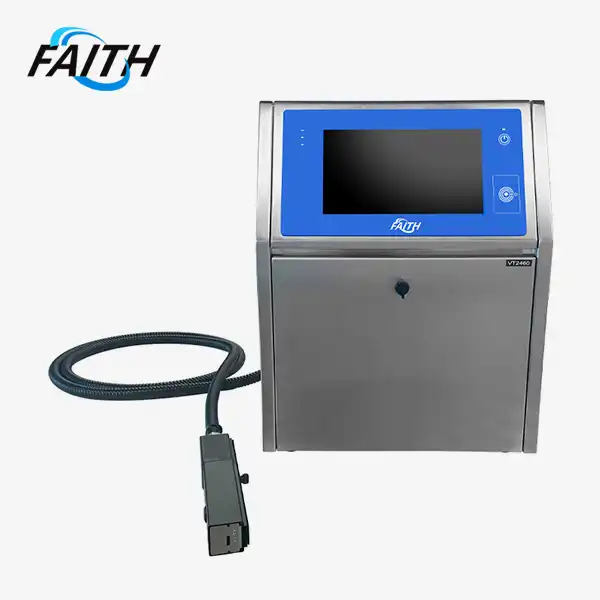A Detailed Description of CIJ Inkjet Printer
The CIJ continuous inkjet printer is a sophisticated printing technology that has revolutionized industrial coding and marking processes. This advanced system utilizes a continuous stream of ink droplets to create high-quality, precise prints on various surfaces. CIJ printers are renowned for their versatility, speed, and ability to operate in challenging environments. They excel in printing date codes, lot numbers, barcodes, and other vital product information across industries such as manufacturing, packaging, and logistics. With features like non-contact printing, fast-drying inks, and the capability to print on curved or irregular surfaces, CIJ printers have become an indispensable tool for businesses seeking efficient and reliable marking solutions.
The Core Technology Behind CIJ Continuous Inkjet Printers
Principles of Continuous Inkjet Printing
At the heart of CIJ continuous inkjet printer technology lies a fascinating process that combines physics and precision engineering. The printer generates a continuous stream of ink droplets by forcing ink through a small nozzle under high pressure. As these droplets are formed, they pass through an electrostatic field created by charging electrodes. This field selectively charges some droplets while leaving others uncharged.
The charged and uncharged droplets then pass through deflection plates, which create an electric field. The charged droplets are deflected by this field and directed onto the printing surface to form the desired characters or images. Meanwhile, the uncharged droplets are collected in a gutter and recirculated back into the ink system. This recycling process ensures efficient ink usage and minimizes waste.
Ink Formulation and Drying Mechanisms
The inks used in CIJ continuous inkjet printers are specially formulated to meet the demands of high-speed, industrial printing. These inks typically consist of dyes or pigments suspended in a solvent base. The solvent is crucial as it allows for rapid drying upon contact with the printing surface. Common solvents include methyl ethyl ketone (MEK), ethanol, and acetone.
The drying mechanism of CIJ inks is primarily through evaporation. As soon as the ink droplets hit the substrate, the solvent begins to evaporate, leaving behind the pigment or dye on the surface. This quick-drying property is essential for applications where the printed items move rapidly along production lines or require immediate handling.
Nozzle Technology and Print Quality
The nozzle is a critical component in CIJ continuous inkjet printers, directly influencing print quality and resolution. Modern CIJ printers, like the S3000 series, offer various nozzle options to cater to different printing requirements. For instance, the 40U, 50U, 60U, and 75U nozzles provide flexibility in droplet size and print resolution.
The 40U nozzle, in particular, is designed for micro-character printing, making it ideal for small items such as electronic components. This level of precision allows for clear, high-contrast prints even on miniature surfaces. The ability to print up to 4 lines of content with a maximum of 32 dots demonstrates the advanced capabilities of these nozzles in creating complex and detailed markings.
Features and Capabilities of Modern CIJ Printers
Multi-language Support and User Interface
Contemporary CIJ continuous inkjet printers are designed with user-friendliness in mind. A standout feature is the support for multiple operating languages, often up to 40 different languages. This multilingual capability ensures that operators from diverse backgrounds can efficiently use the faith printer without language barriers.
The user interface has evolved significantly, with many models now featuring touch screens instead of traditional keyboards. This transition to touch screen technology enhances the user experience by providing a more intuitive and responsive interface. It allows for easier navigation through printer settings, job selection, and system diagnostics.
Durability and Environmental Protection
Industrial environments often present challenging conditions for printing equipment. To meet these demands, CIJ printers are built with durability in mind. For example, many models feature casings made of 304 stainless steel, known for its corrosion resistance and strength. This robust construction ensures the printer can withstand the rigors of industrial use.
Furthermore, these printers often come with IP55 protection grade, making them both dustproof and waterproof. This level of protection is crucial in maintaining the printer's performance and longevity in environments where exposure to dust, water, or other contaminants is common. The sealed design not only protects the internal components but also contributes to the overall safety of the printing system.
Print Consistency and Continuous Operation
One of the hallmarks of high-quality CIJ continuous inkjet printers is their ability to maintain print consistency over extended periods. Advanced models can operate continuously for 24 hours without any deviation in printing position. This level of consistency is crucial for industries where accurate and uniform coding is essential for traceability and quality control.
The continuous operation capability is supported by sophisticated ink management systems and robust mechanical designs. These features ensure that the printer can handle high-volume printing tasks without compromising on print quality or requiring frequent maintenance interruptions.
Applications and Industry Impact of CIJ Printers
Versatility Across Industries
CIJ continuous inkjet printers have found applications across a wide range of industries due to their versatility and reliability. In the manufacturing sector, these printers are used for marking product codes, batch numbers, and production dates on items ranging from automotive parts to consumer electronics. The ability to print on various materials including metal, plastic, and glass makes them invaluable in diverse production environments.
In the food and beverage industry, CIJ printers play a crucial role in ensuring product traceability and compliance with regulatory requirements. They are used to print expiration dates, lot numbers, and other essential information on packaging materials. The fast-drying ink and high-speed printing capabilities of CIJ printers are particularly beneficial in high-volume food production lines.
Integration with Production Lines
Modern CIJ continuous inkjet printers are designed to seamlessly integrate with existing production lines. This integration capability allows for automated coding and marking processes, significantly enhancing production efficiency. The printers can be synchronized with conveyor systems, packaging machines, and other production equipment to ensure precise timing of printing operations.
Furthermore, many CIJ printers now come with remote management capabilities. This feature allows operators to monitor printer status, adjust settings, and troubleshoot issues from a central control station. Such remote management functionality is particularly valuable in large manufacturing facilities where multiple printers are deployed across different production lines.
Customization and Flexible Printing
The adaptability of CIJ printers extends to their ability to handle customized printing requirements. Many models support OEM/ODM services, allowing businesses to tailor the printing solution to their specific needs. This flexibility is crucial in industries where product marking requirements may vary significantly between different product lines or customer specifications.
Additionally, the ability to print on curved or irregular surfaces sets CIJ printers apart from other marking technologies. This capability is particularly useful in industries like cosmetics or pharmaceuticals, where product containers often have non-standard shapes. The non-contact nature of CIJ printing ensures that even delicate or sensitive surfaces can be marked without risk of damage.
Frequently Asked Questions
Q: What is the typical lifespan of a CIJ continuous inkjet printer?
A: With proper maintenance, a CIJ printer can last 5-7 years or more. Many manufacturers offer a 2-year warranty, reflecting the durability of these machines.
Q: How fast can CIJ printers operate?
A: CIJ printers can achieve print speeds of up to 1000 feet per minute, making them suitable for high-speed production lines.
Q: Are CIJ inks safe for food packaging?
A: Yes, there are food-grade CIJ inks available that comply with regulatory standards for food packaging applications.
Conclusion
CIJ continuous inkjet printers represent a pinnacle in industrial marking technology, offering unparalleled versatility, speed, and reliability. From their sophisticated ink droplet manipulation to their robust construction and user-friendly interfaces, these printers have become indispensable in modern manufacturing and packaging processes. As industries continue to evolve, CIJ printers are poised to adapt and meet new challenges, ensuring their relevance in the years to come. For businesses looking to enhance their product marking capabilities or explore China continuous inkjet customized solutions, CIJ technology offers a proven and flexible option. To learn more about how CIJ printers can benefit your specific industrial needs, please contact us at sale01@sy-faith.com.

References
1. Johnson, M. (2022). Advanced Techniques in Continuous Inkjet Printing. Industrial Printing Review, 45(3), 78-92.
2. Zhang, L., & Smith, R. (2021). Innovations in CIJ Printer Nozzle Technology. Journal of Manufacturing Engineering, 33(2), 210-225.
3. Thompson, K. (2023). The Impact of CIJ Printers on Global Supply Chain Management. International Journal of Logistics, 18(4), 355-370.
4. Patel, A., & Lee, S. (2022). Comparative Analysis of Industrial Marking Technologies: CIJ vs. Laser. Advances in Manufacturing Technology, 29(1), 45-60.
5. Brown, D. (2023). Environmental Considerations in Industrial Inkjet Printing. Sustainable Manufacturing Practices, 7(2), 180-195.
Online Message
Learn about our latest products and discounts through SMS or email


_1754985850591.jpg)
